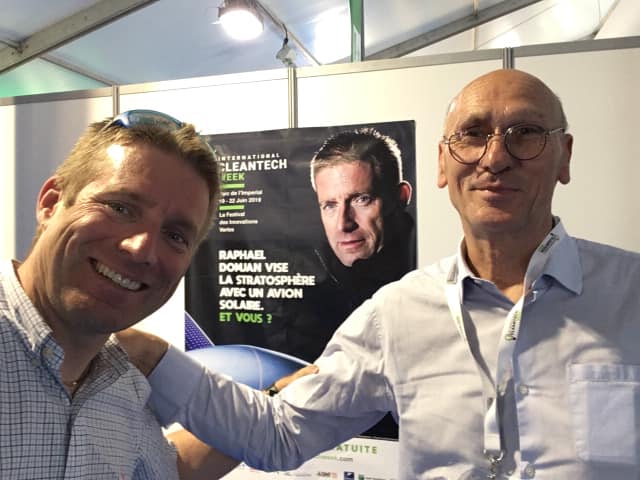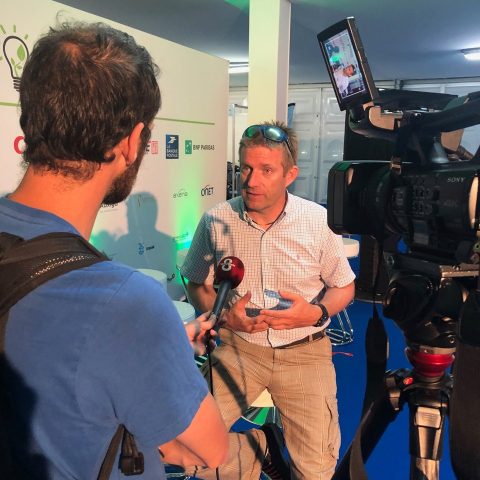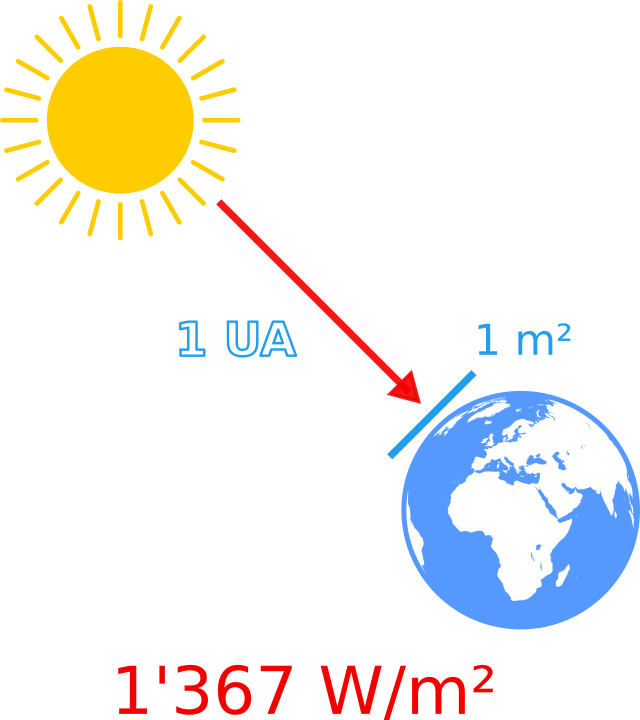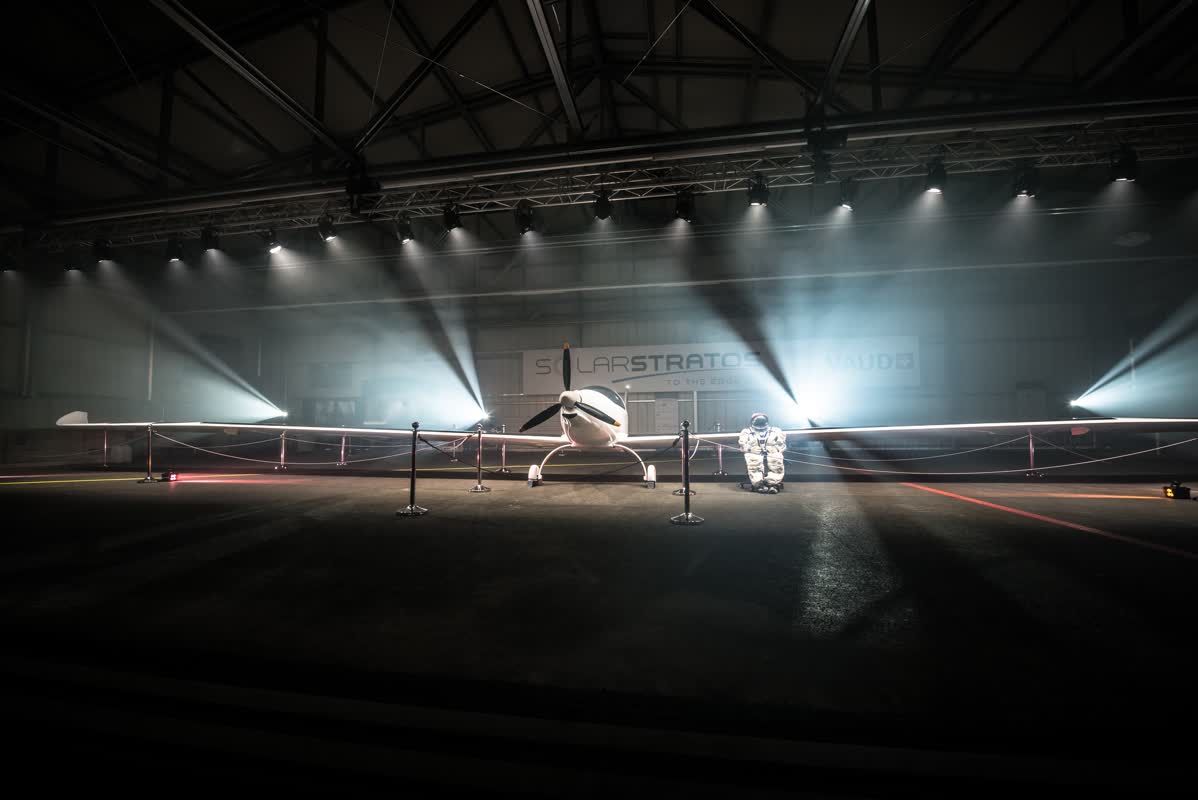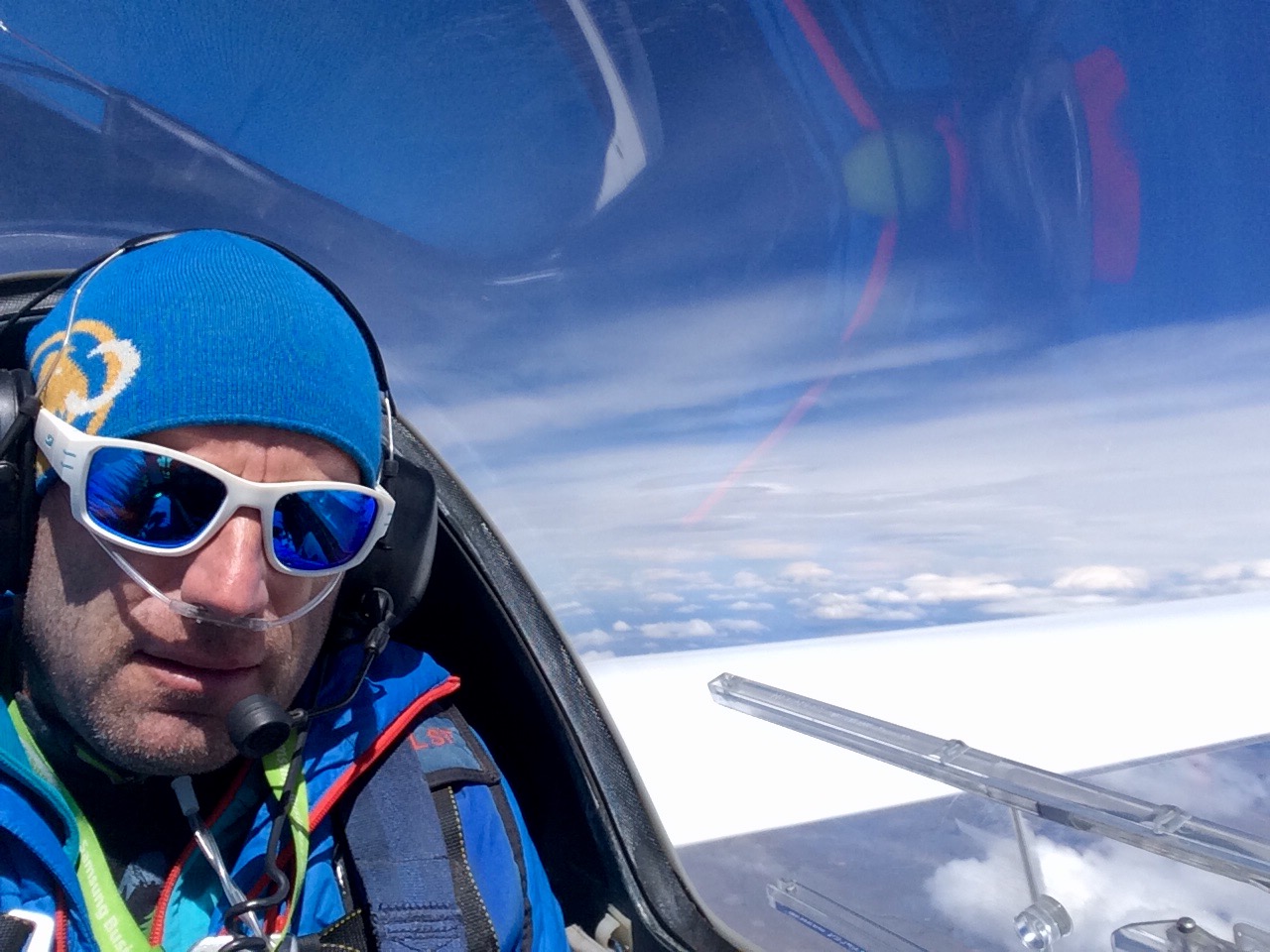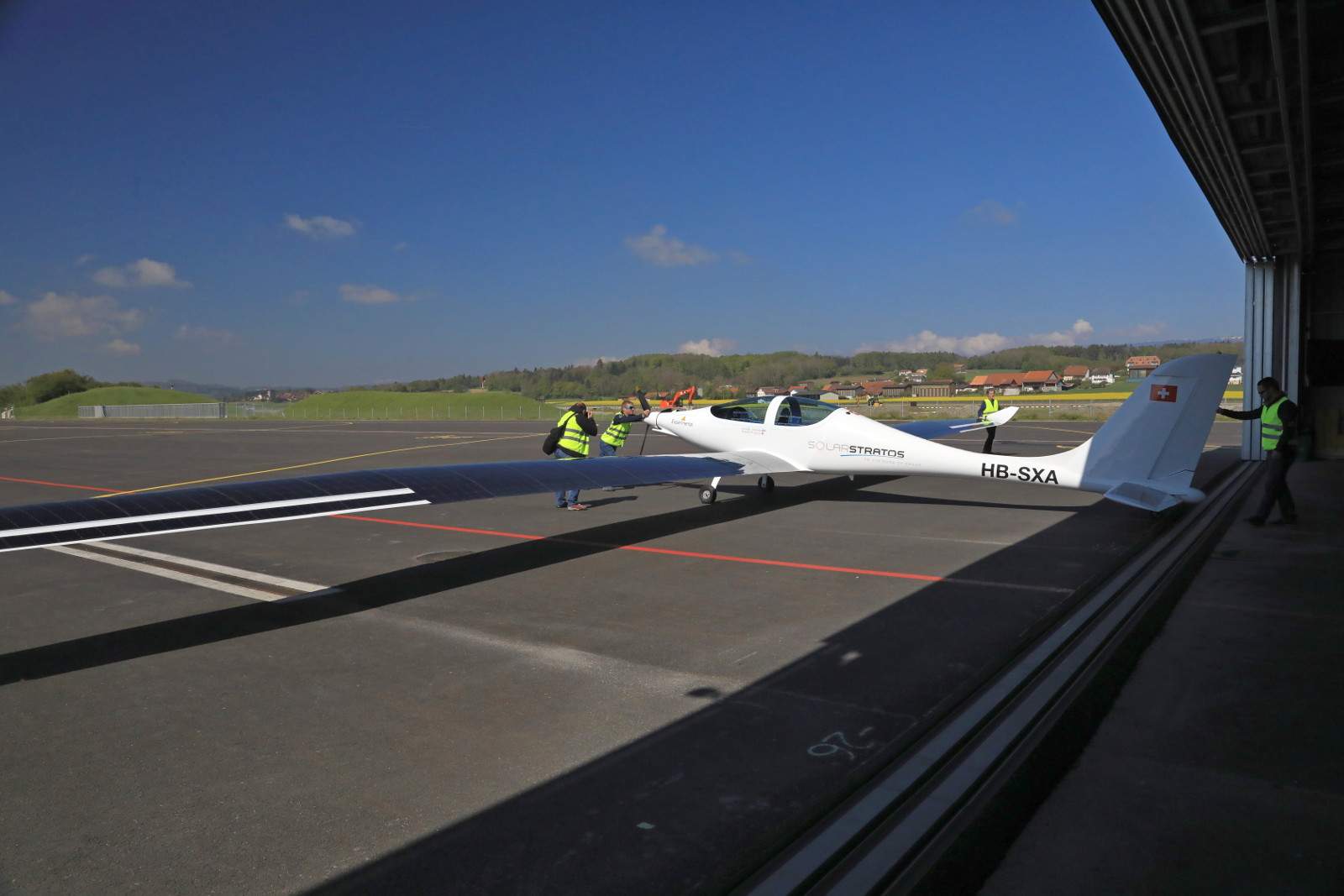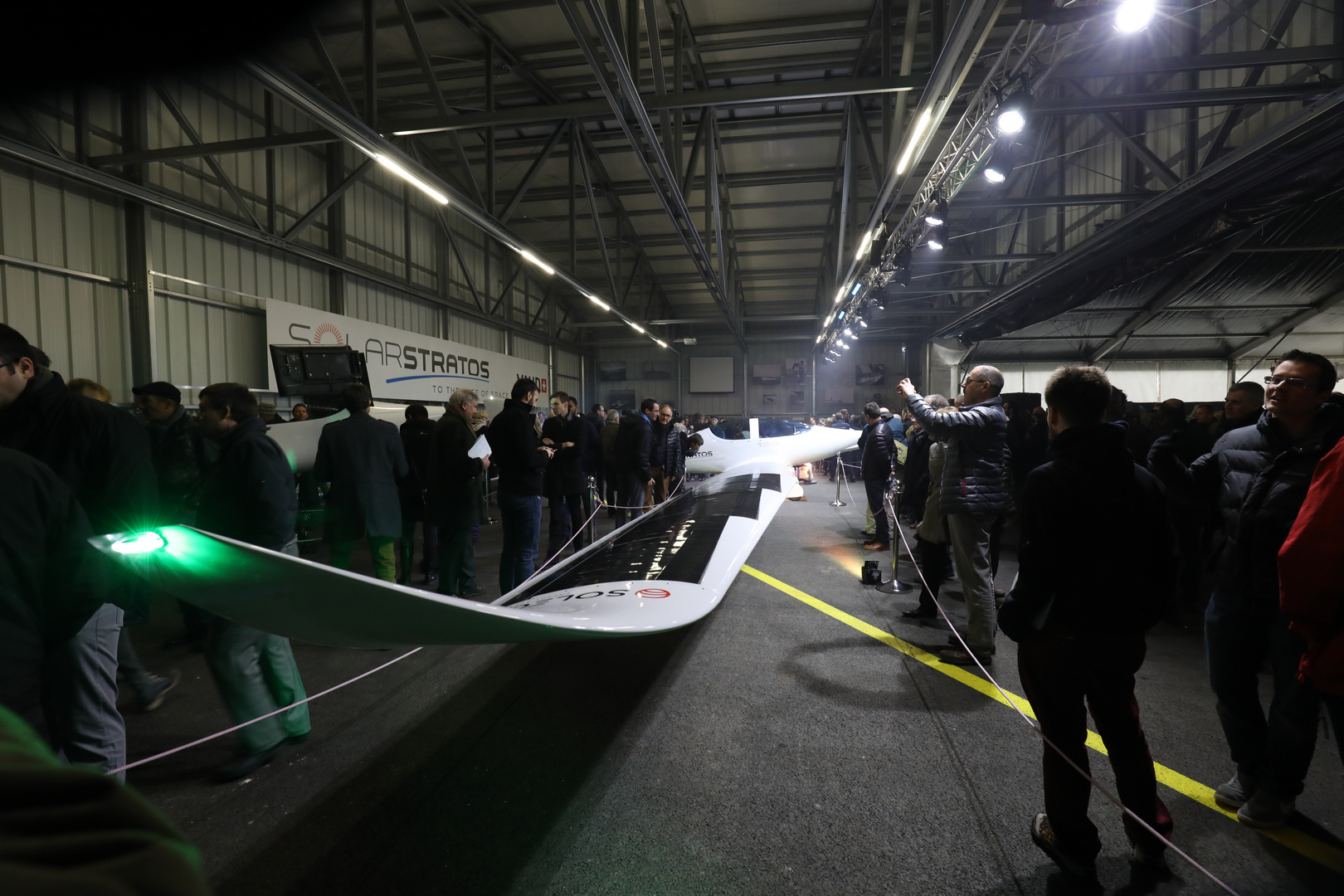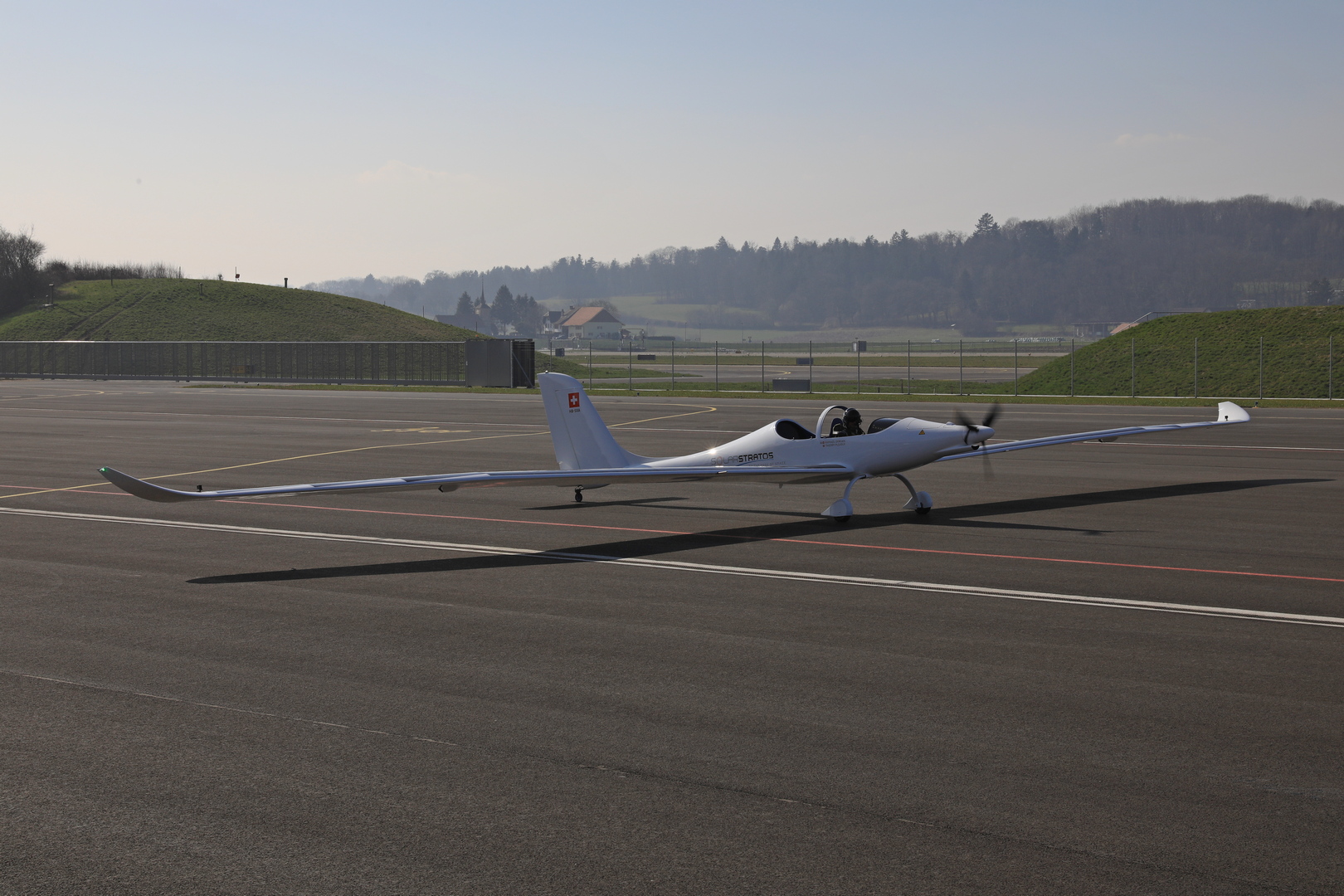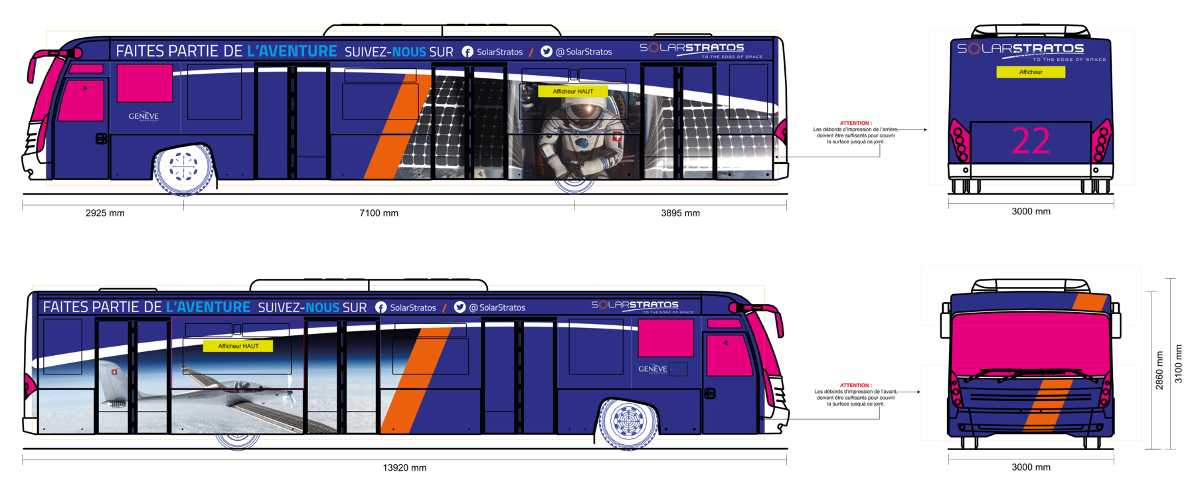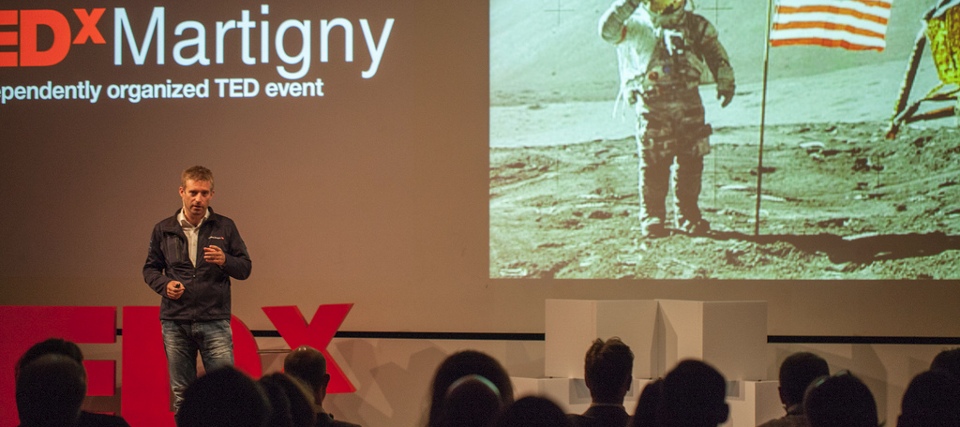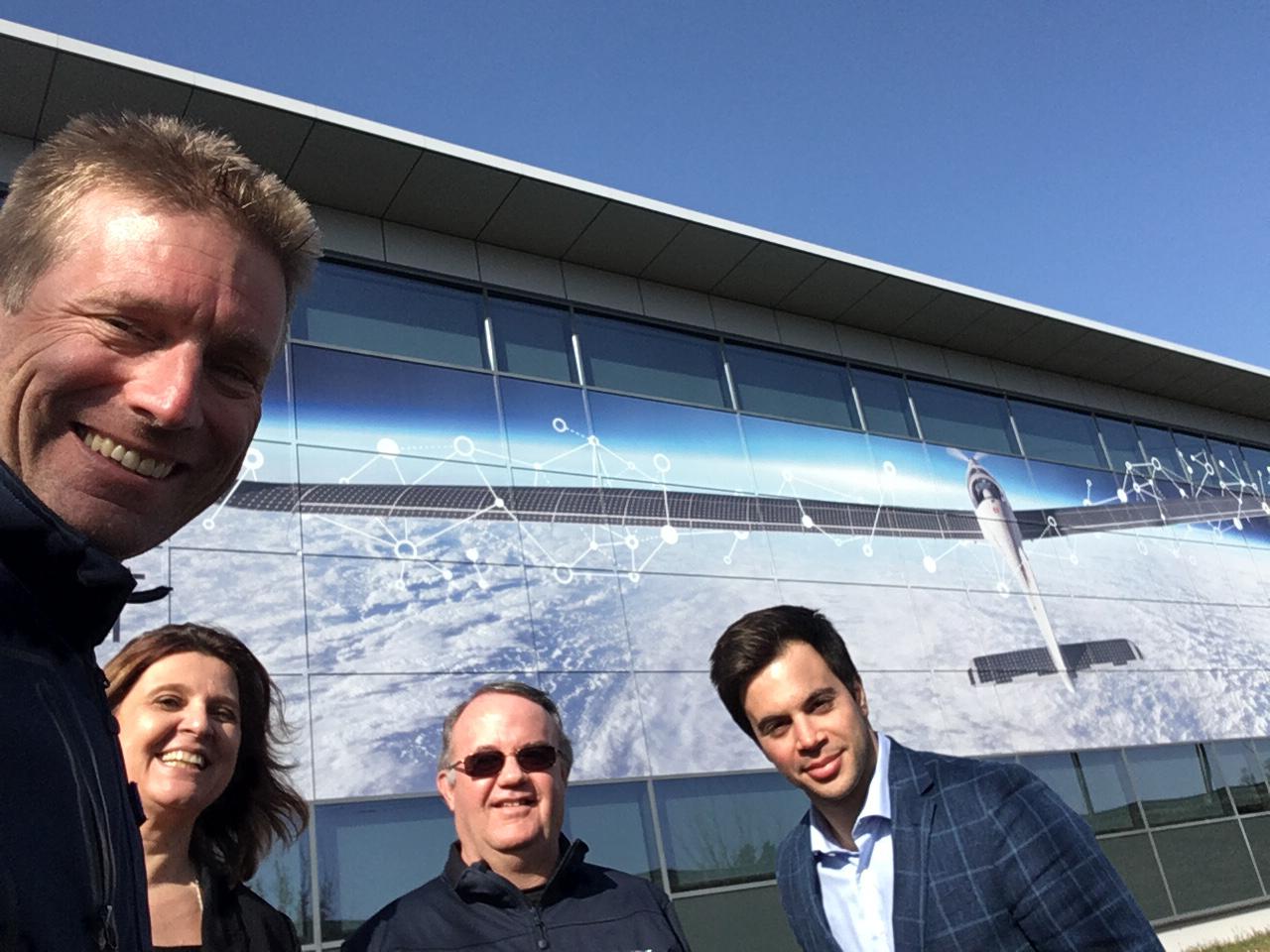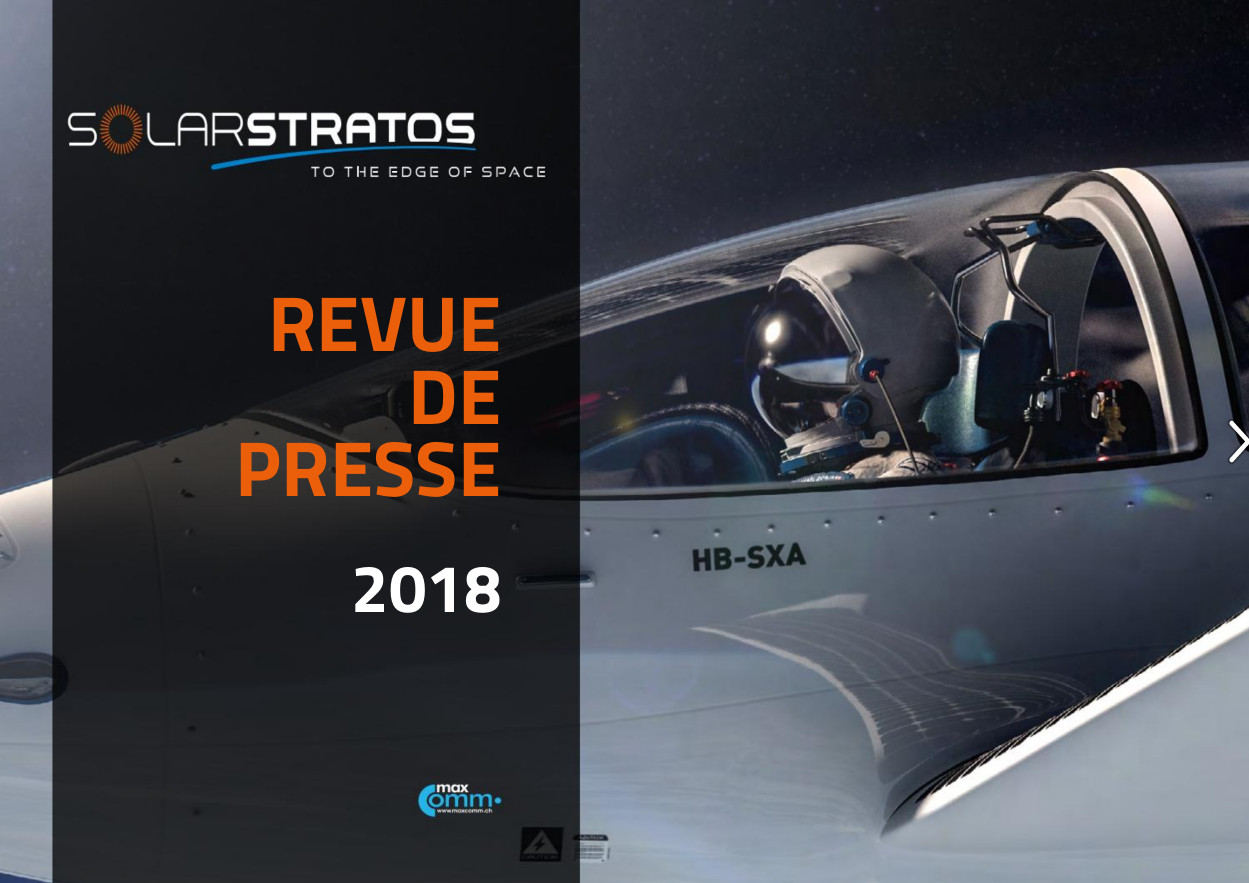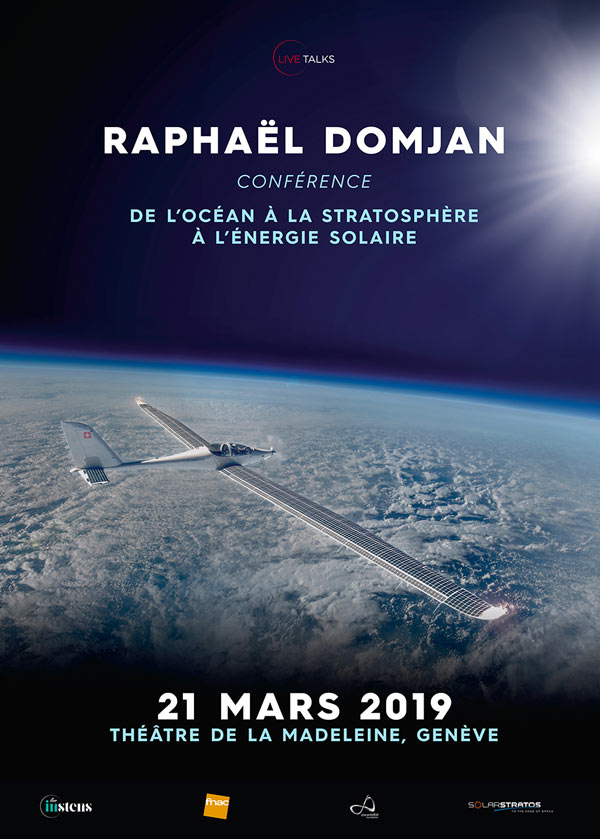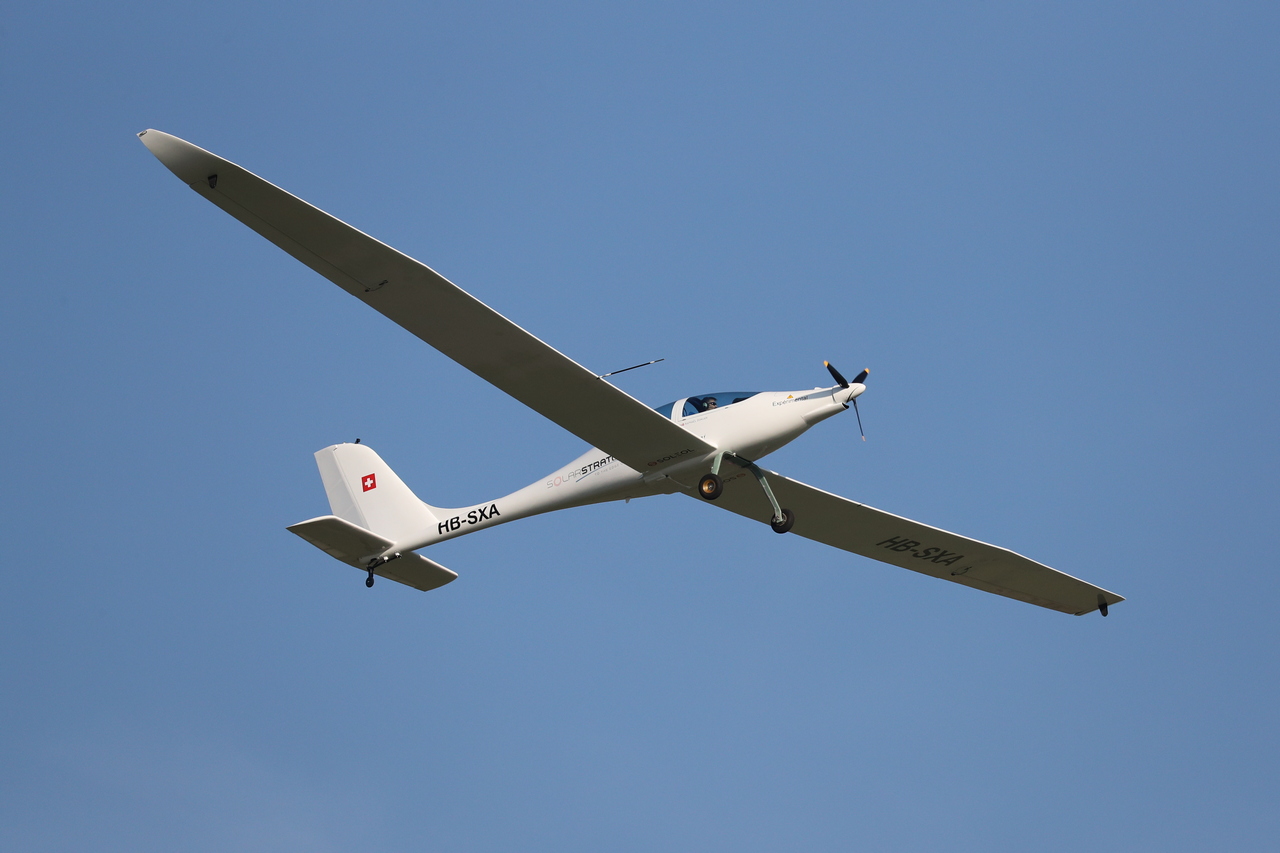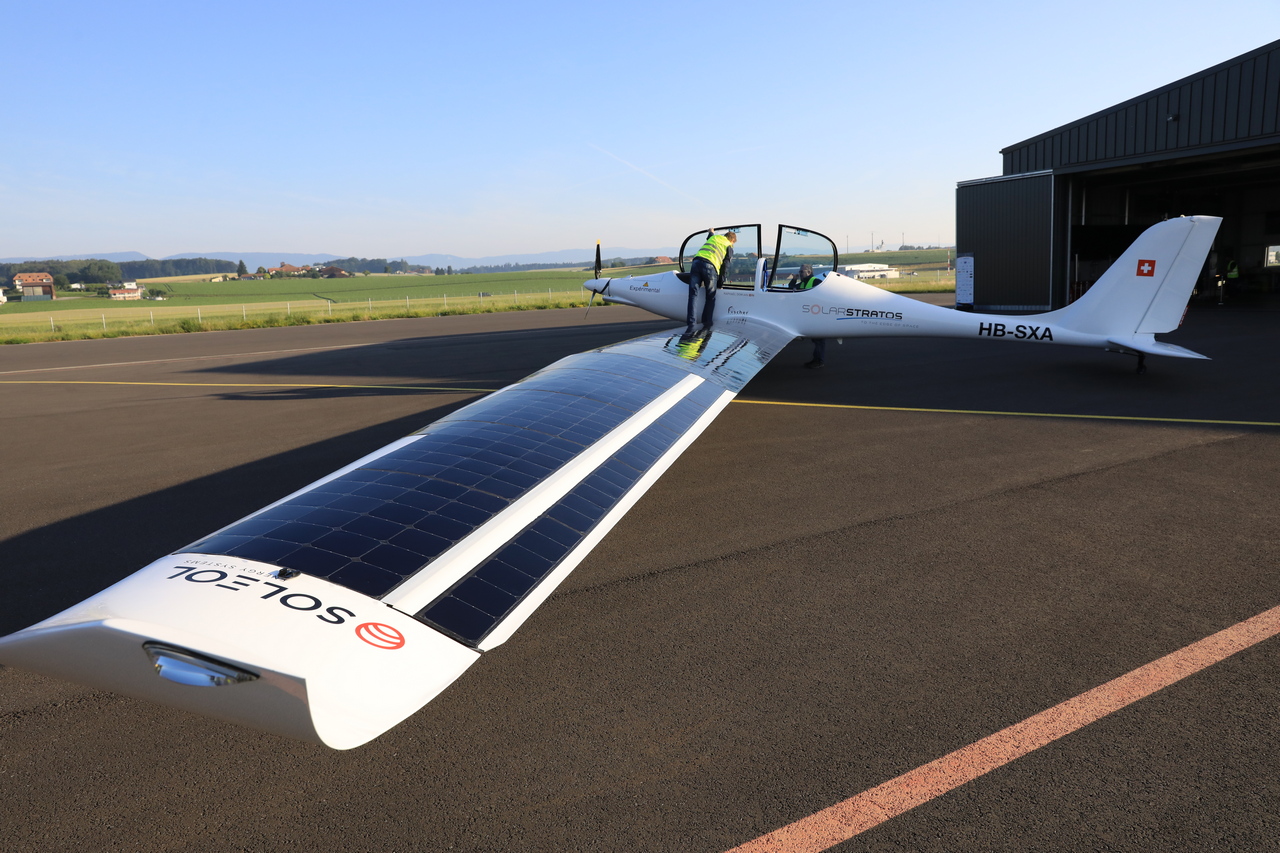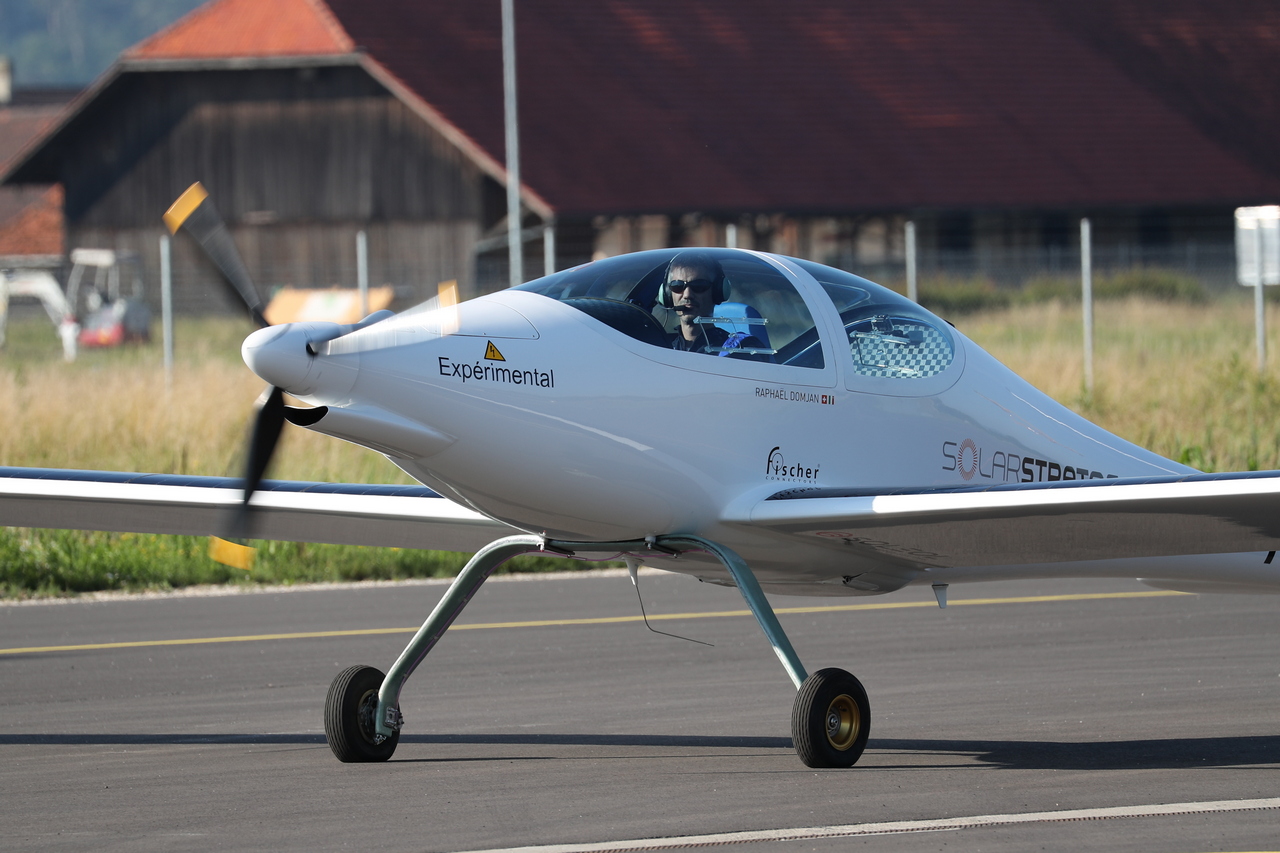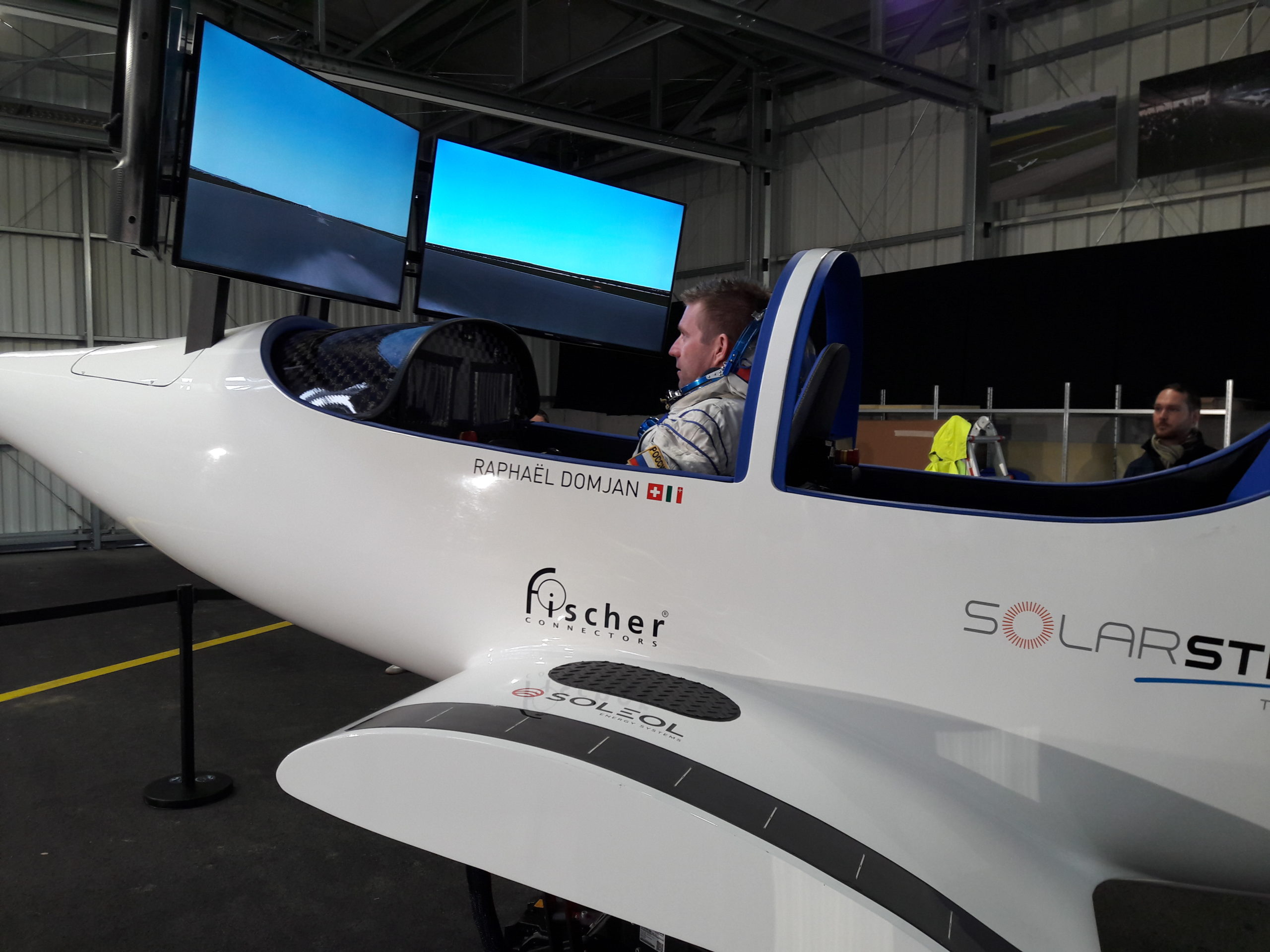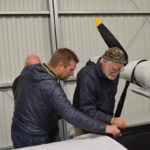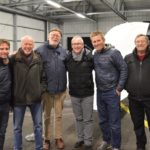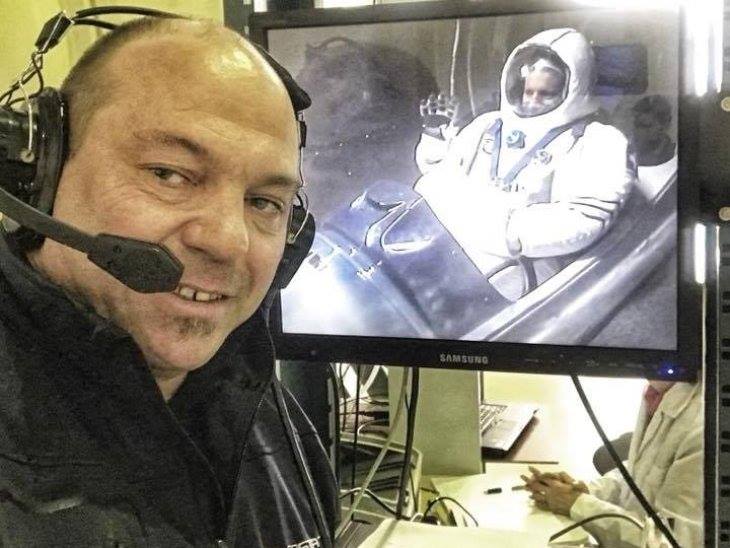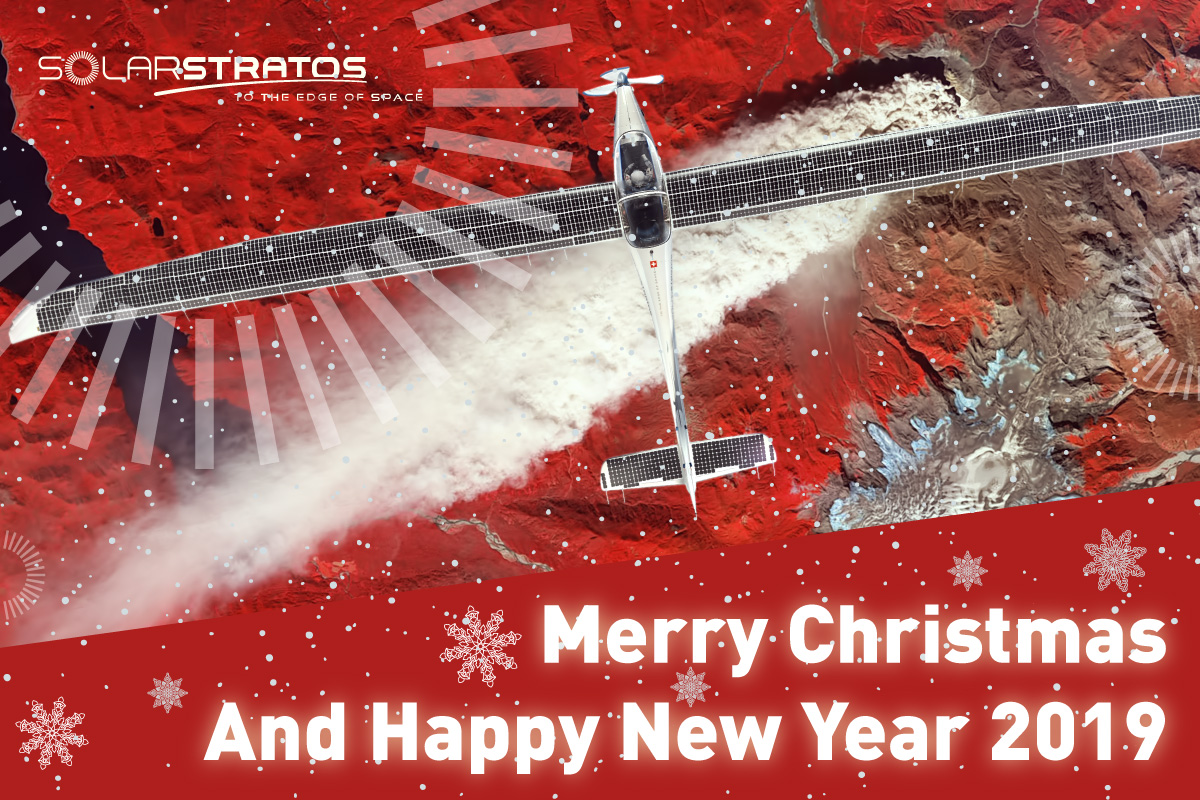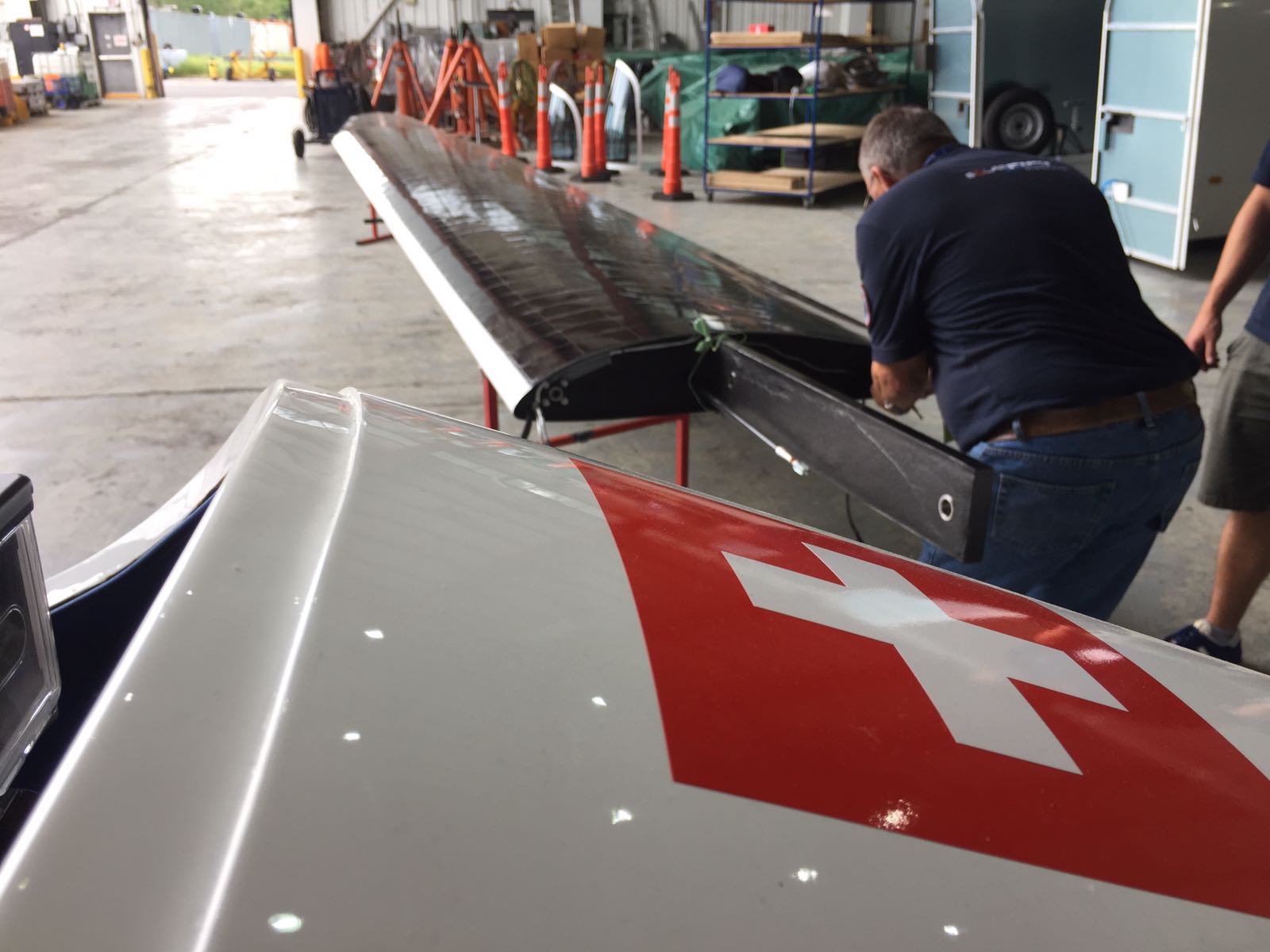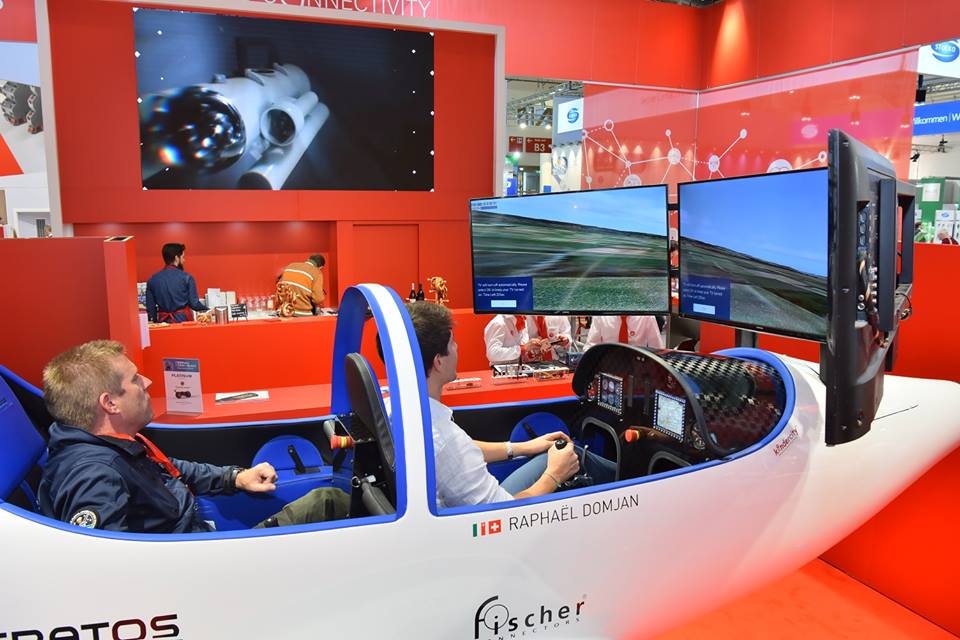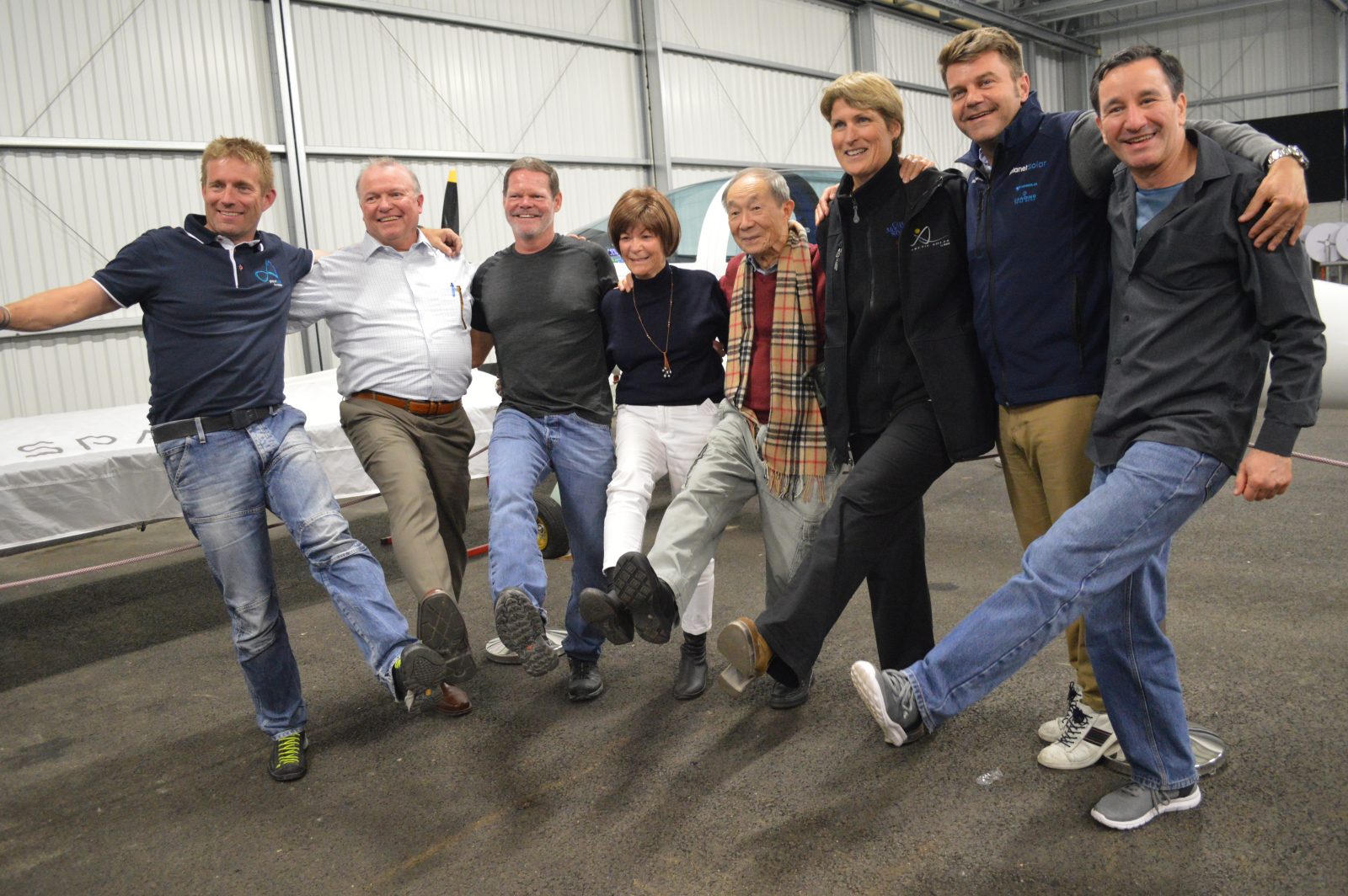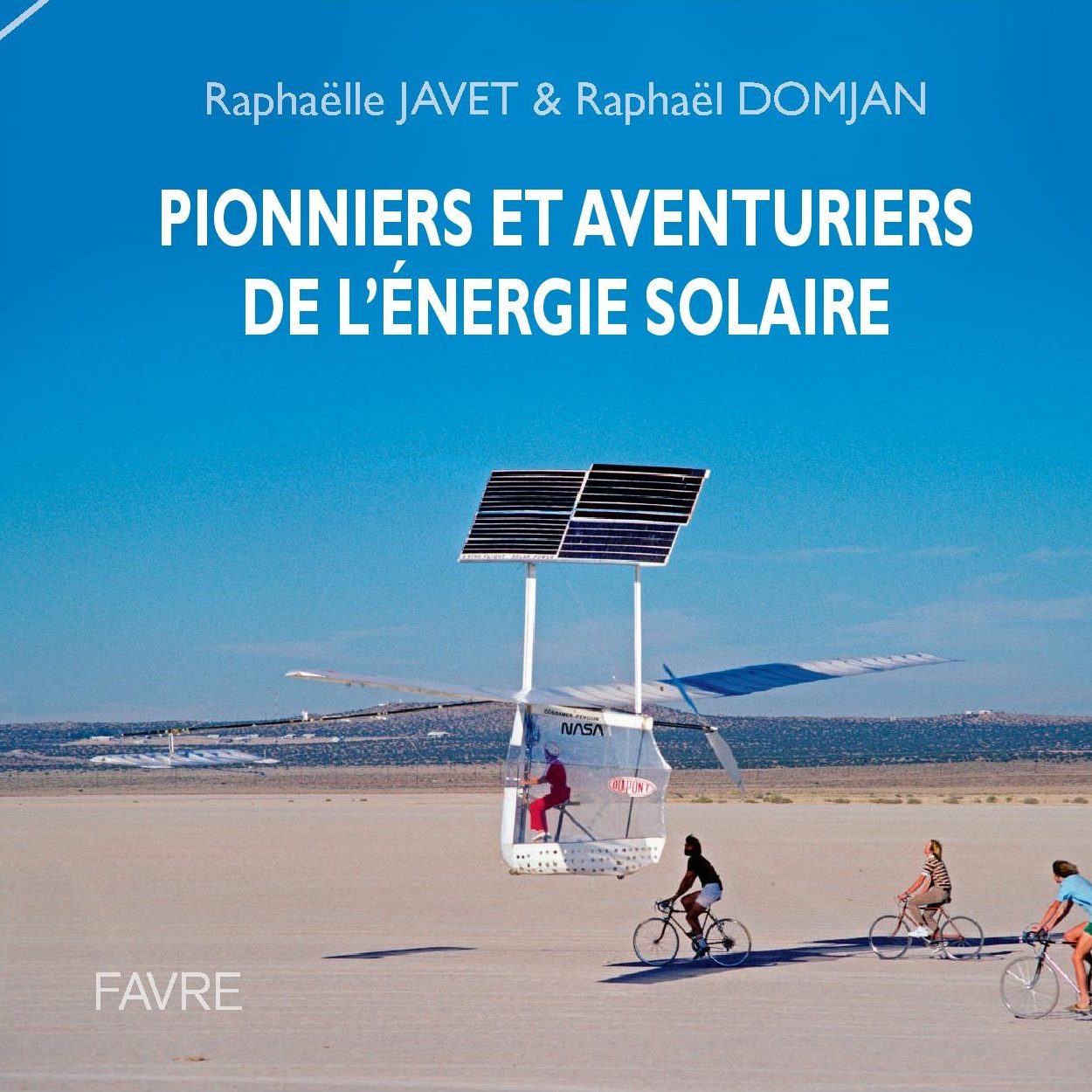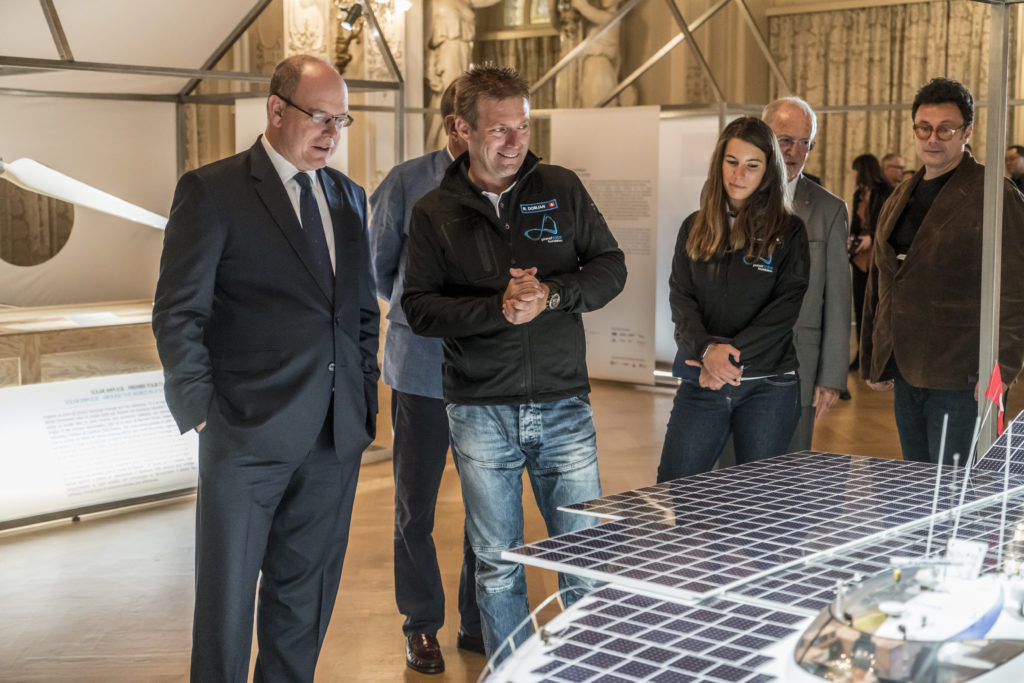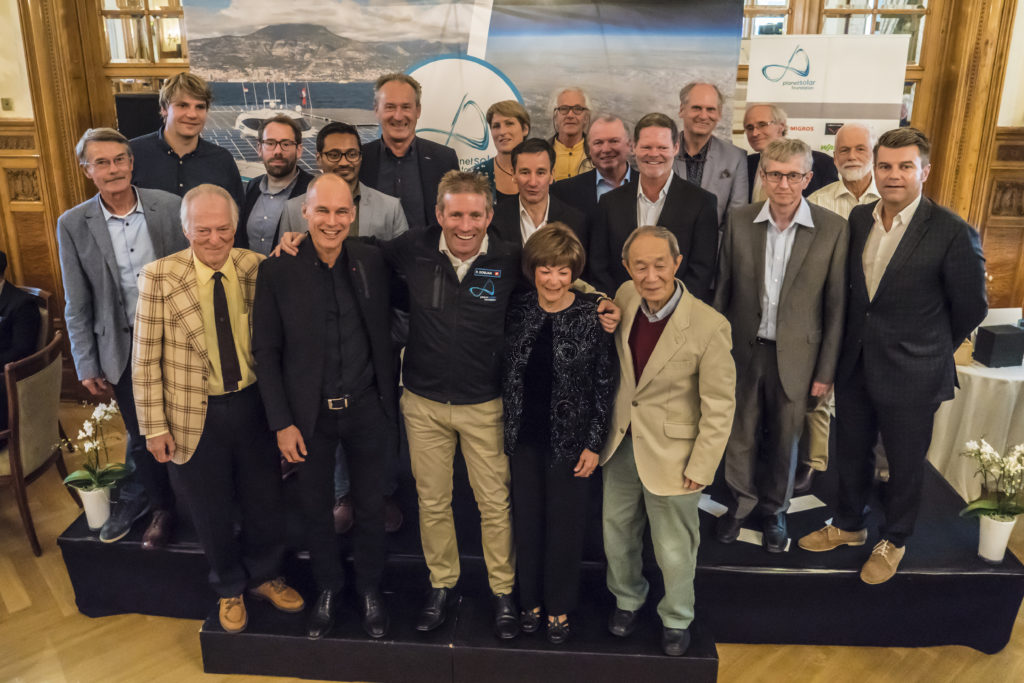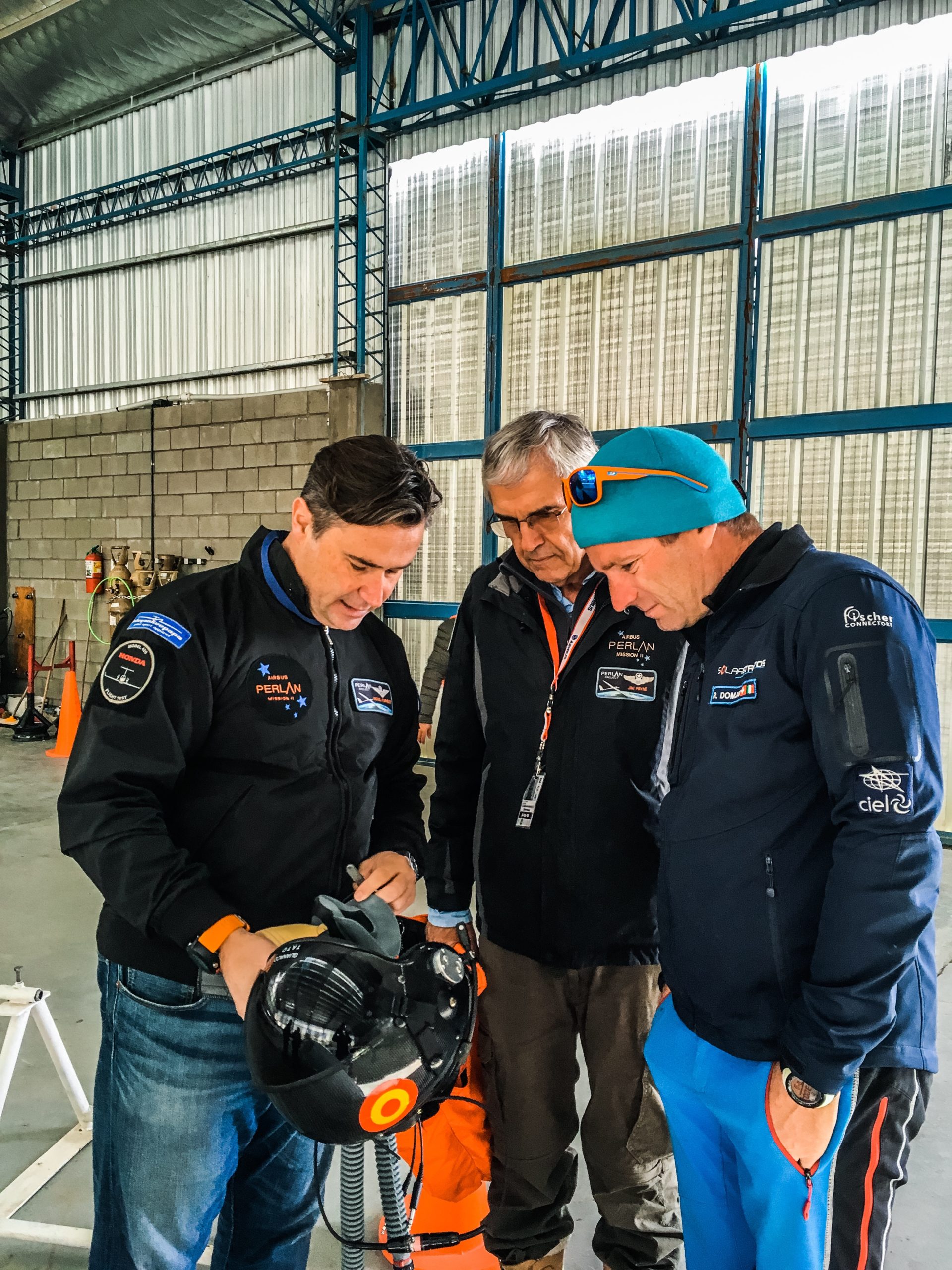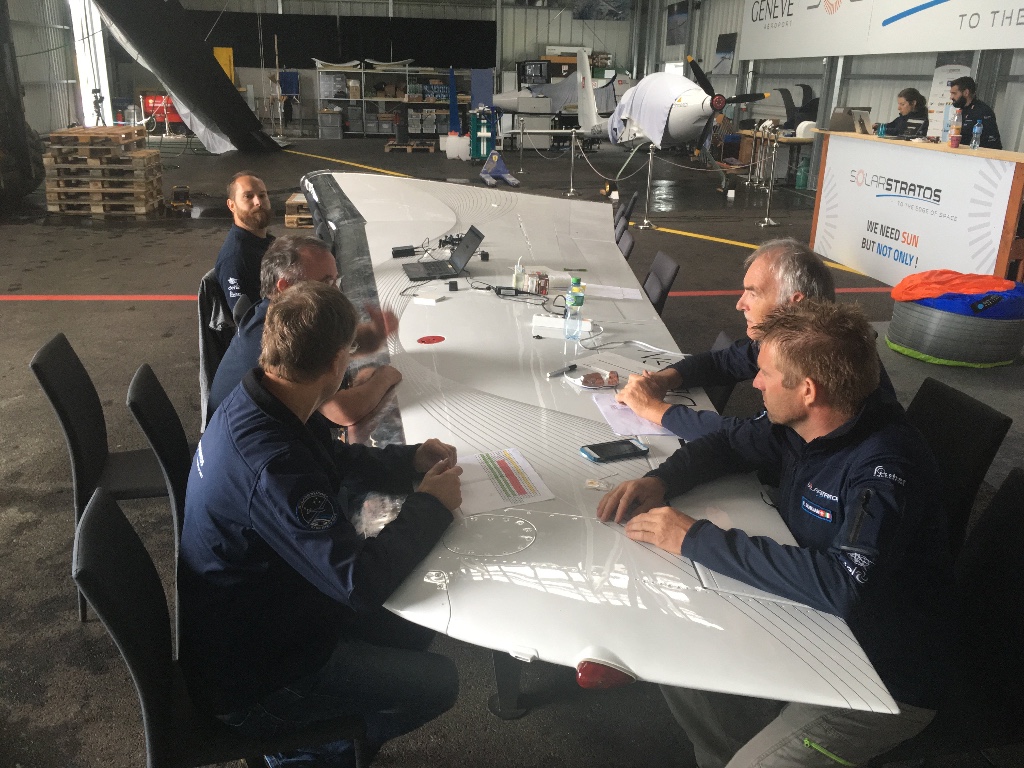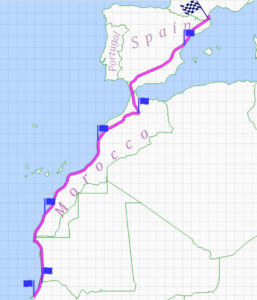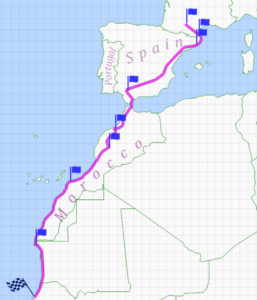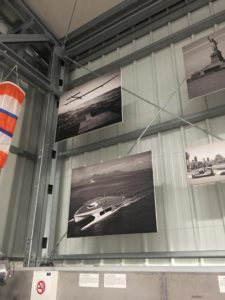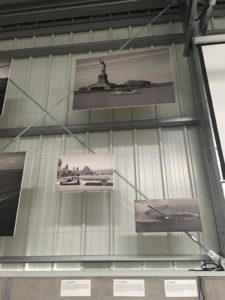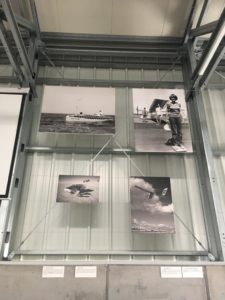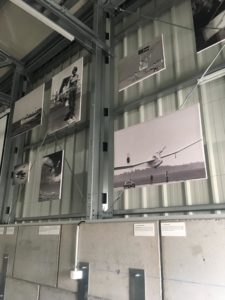Raphaël à la Cleantech Week
June saw Raphaël Domjan travel to Annecy for International Cleantech Week (19-22 June) where he took on the role of Ambassador of Renewable Energies, spreading the word and promoting solar energy. It was an opportunity for the eco-explorer to participate in a conference dedicated to green innovation and the perfect moment to raise awareness of the SolarStratos mission.
Meeting science journalists
On 5 July, the world’s scientific media will gather in Lausanne at the SwissTech Convention Centre of EPFL for the World Conference of Science Journalists, organised by the Swiss Association for Science Journalism. The event is supported by Swiss political, media and economic circles, including the State Secretariat for Education, Research and Innovation, Presence Swiss, the Canton of Vaud and the City of Lausanne. It will give participants the opportunity to reflect on good practice and the values of the profession, and to discover new tools to implement them.
Raphaël Domjan will present the SolarStratos mission and the potential of solar energy, highlighting the experimental and innovative aspects of the project. Christophe Ballif, the director of CSEM, SolarStratos’ technological and scientific partner, will also take part. And everyone attending the event will visit the SolarStratos base in Payerne.
What is the solar constant?
The solar constant is the quantity of solar energy measured over a 1 m² area located at a distance of 1 au (the astronomical unit was invented in 1958 to measure the distance between objects in the solar system. An astronomical unit measures 149’597’870.7 km, which is the average distance between the Earth and the Sun), exposed perpendicular to the sun’s rays and in the absence of atmosphere (filters). The value of the constant, also called power, is 1 367 W/m² (source: Wikipedia)
For SolarStratos, the solar constant and the values associated with it are at the heart of the multitude of measurements that allow optimal use of this infinite source of energy. The success of the SolarStratos mission relies on it.
New partner
SolarStratos is proud to welcome French telecommunications company Serveurcom onboard as partner and official supplier and extends it thanks to president Damien Watine and his team for their trust.
National Day speeches
Raphaël Domjan is honoured to be giving two National Day speeches,
the first on 31 July at Great Beroche/NE (Port of Saint-Aubin-Sauges)
and the second on 1 August at Yverdon-les-Bains/VD alongside Federal Councillor, Alain Berset.
It’s summer, let’s recharge the batteries!
Summer break is fast approaching and along with it, the opportunity for everyone to recharge their batteries and top up on energy – preferably solar!
The SolarStratos team wishes you a wonderful sunny summer and is looking forward to seeing you again at the start of the season when the team will be undertaking new test flights!
Thank you as ever for your support, it is very precious to us.
Best wishes
The SolarStratos team.
The SolarStratos base, functional and welcoming
SolarStratos HQ is located at the heart of the Payerne air base, it is functional, welcoming and well adapted to the needs of our eco-adventure. We can take care of our stratospheric solar aircraft while offering other interesting opportunities.
“The base was built in 2015. It houses our plane, the flight simulator that Raphaël Domjan uses to train, plus a workshop. It also has an area for us to comfortably receive our partners, media and groups of visitors and to organise our work sessions,” explained Roland Loos, SolarStratos CEO.
“Our operational base is of paramount importance; it is both a communications tool and an opportunity to bring guests closer to the aircraft. There is a technical area and an area dedicated to receiving guests which has a photo exhibition of solar vehicle on display in partnership between the PlanetSolar Foundation and SolarStratos.
Since the beginning of our eco-adventure, we have sought to stay close to the public. Our partners are also regularly invited to Payerne and the feedback from their visits is usually very positive. Entering the base and seeing the plane is always a magical moment.”
The importance of physical preparation
Reaching the stratosphere in a solar plane is not only a feat of technology, it is also a test of physical ability and to climb to such heights, Raphaël Domjan must be in peak physical condition. To achieve this, he follows an intense sports programme with three to four sessions a week that include swimming, biking, running, climbing and in the winter season, he also cross-country skis.
“I have always needed to move and to do a lot of sport in order to feel good. Our eco-adventure motivates me even more, knowing that I must be in peak physical condition to reach the stratosphere,” explained Raphaël.
Raphaël loves flying, it is his passion and with over 200 hours logged annually, he maintains a high level of experience. This will be crucial when it comes to flying in the stratosphere where he’ll be able to contemplate the Earth’s curvature and to observe the stars in broad daylight!
He mainly flies gliders, large and light aircraft that are as similar as possible to SolarStratos, but he also jumps at the opportunity to fly a helicopter or to leap out of a plane with a parachute. His preferred flight paths are over Yverdon-les-Bains and Colombier.
New – SolarStratos on Linkedin
With over 25,000 followers on Facebook, Instagram and Twitter, we thought we’d expand our network even further and have just launched SolarStratos on LinkedIn. This social network needs little introduction – it is dedicated to professional and entrepreneurial activities and is therefore of value to SolarStratos. We would be delighted to welcome you to our page and hope to continue to share our eco-adventure with you there – come and join us! https://www.linkedin.com/company/solarstratos-sa/
And for those that would like to find us on our other social channels, please go to:
https://www.facebook.com/SolarStratos – @solarstratos
https://www.instagram.com/solarstratos – #solarstratos
https://twitter.com/solarstratos – @solarstratos
Test flights resume in July
The countdown has started and Raphael Domjan and the team are watching the clock! They are putting everything they’ve got behind the effort to be ready by July when SolarStratos is scheduled to take off again from the Payerne aerodrome.
The summer promises to be busy, in August, Raphael will begin his SolarStratos training, followed shortly by his first double-handed solar test flights.
New generation solar cells
The SolarStratos mission is experimental and avant-garde – a happy convenience for the project’s scientific and technological partners that have seized the opportunity to test components in extreme conditions and a happy situation for the team who benefit from state-of-the-art next generation technologies.
One such technology are the photovoltaic cells currently in development and which will be fitted to the wings of the solar aircraft. Higher potential for solar power generation, greater flexibility and lower weight are among the planned improvements.
Concrete steps in development
You cannot improvise when powered by solar energy, that much is clear! During the winter, the SolarStratos team has carried out stress tests on the fuselage, wings and spars. These will continue in the coming months to ensure maximum safety for the project and so far, everything is going to plan with the team and plane constantly evolving. New learning is being reinvested in the project and its development and every step brings the team closer to resuming the test flights.
New partner
We are delighted to welcome Planzer Transport AG on board as a partner. The Swiss transportation company, founded in 1936, will provide good exposure for our stratospheric mission with two SolarStratos branded trucks driving the roads of Switzerland! Our thanks to the management of Planzer Transport AG for their support.
The question: how can a propeller plane fly without air?
A very valid question! When you enter the stratosphere at over 18,000 metres (approx. 60,000 ft), air is scarce, but not absent. There is enough for a propeller to work, the same applies to the wings – there is enough air for them to carry the plane. Conversely, a combustion engine does not work at this height. In space, the re-entry interface is considered to be at 130 km (400,000 ft), so much higher than where SolarStratos intends to fly.
Increased performance
As you know, our development programme and test flights were temporarily delayed last autumn due to a breakage during a routine stress test, but in the spirit of SolarStratos, we managed to convert the delay into an opportunity and have used the time to improve and develop. As a result, our new wings currently being built in Wohlen, Switzerland, will be lighter and have larger winglets.
The good news is that we will be flying again this summer – we can’t wait!
We are infinitely grateful to our partners and supporters who have stuck by us throughout these challenges, it is largely thanks to them and all of you that we will soon be taking off again! Thank you all for your unwavering loyalty, support and trust.
The initial winglets of the SolarStratos aircraft were slightly curved. The new ones, currently being designed, are larger and have a more pronounced angle. © SolarStratos / Ali Eichenberger
Wings in build
In just a few weeks, after four months of careful construction in Wohlen, Switzerland, the new wings and beams that fix the wings to the fuselage will emerge from the shed.
The beams, hidden inside the wings, support most of the load. © SolarStratos
Ride the SolarStratos bus at GEneva Airport
If you’re lucky, on your next visit to Geneva Airport, you will ride the SolarStratos electric bus between the terminal and your plane. This is the latest initiative by our official partner, Geneva Airport, to raise awareness of our eco-exploration project!
We extend a big thank you to airport management and in particular to general manager, Mr. Andre Schneider.
Raphaël Domjan ti attend international gathering on sustainable mobility
Raphael Domjan has been invited to attend an international gathering in St Tropez in the autumn on sustainable mobility. Discussions between eco adventurers and experts on new technology in air, maritime and land travel are on the agenda.
Yet another great opportunity to further the SolarStratos values and mission!
Link to international meeting on sustainable mobility
Celabrating SolarStratos
Our partners are deeply involved in the development of our project and Fischer Connectors has recently given us a very visual example of the excellent support we receive, decorating their St Prex façade in SolarStratos colours. So now, if you take the train from Geneva to Lausanne, keep an eye open for the new look!
Meanwhile in Payerne, the optimisation work continues apace, and the team is eager to roll the plane out of the hangar and to see it flying again. Stay posted for an update soon.
A toasty spacesuit
Our partner, Zvezda, has further developed the Sokol 2 spacesuit that Raphael Domjan will wear to fly the plane to include an integrated heating system. They have also insulated the head and hands, reinforced the connectors, developed a basic cockpit simulator and integrated a “Life Support” system that will assist the pilot during the stratospheric flight.
At the end of January in Moscow, Zvezda presented the developments to the SolarStratos team, including our expert astronaut, Jean-Francois Clervoy. Unfortunately, Raphael had the flu and couldn’t complete the tests during this visit. These will be rescheduled for the very near future.
What defines the stratosphere ?
Raphael Domjan and SolarStratos are on a mission to conquer the stratosphere, but do we know what really defines it? Borders in space are not formally defined. NASA, for example, has historically called the moment when a returning spaceship is at 400,000 feet or 130km. Otherwise, to be called an astronaut, you have to have flown at an altitude of over 100kms. As a point of reference, the International Space Station is situated at an average altitude of 400km.
The stratosphere extends on average from 12-15km up to about 50km of altitude. Today, the tendency is to refer to ‘near space’ to define the area from 16-18 km to 100 km, this is the area between where aircraft fly (flight level 600-60,000 feet or approx. 20 km, above which there is no longer air control) and 100 km (the lowest limit for satellites to orbit). Currently only space rockets and balloons navigate this area, there is very little activity.
This is our destination. Our mission is to fly in this space using solar power as there is not enough oxygen to power aircraft engines operating on hydrocarbons. From 16,000 m, Raphael will be flying in the stratosphere with more than 95% of the atmosphere beneath him.
Press review and statistics
SolarStratos enjoyed significant media coverage in 2018 with several news and behind the scenes feature stories. Raphael Domjan and the SolarStratos team were also very active across the project’s social media channels. Click on the link for the 2018 media highlights.
Raphael’s public lecture in Geneva
On 21 March, Raphael Domjan will give a public lecture titled ‘From the ocean to the stratosphere powered by solar energy’ at the Madeleine theatre in Geneva. Our eco-explorer will present the story of PlanetSolar, the first ever boat to go around the world powered by solar energy. He will also present the SolarStratos mission that combines a dream, innovation and energy efficiency and demonstrate the potential of renewable energy. For more information and to attend, please click here.
Lighter wings
We’ve learned a lot last year, and our project benefits from this knowledge. As a result, SolarStratos’ wings will from now on be equipped with “new generation” winglets, who will help save 10 kilos per wing! This will help reduce the consumption of energy, and therefore the number and volume of batteries needed. Our goal is always to be as light as possible, and the weight of the aircraft should not exceed 600 kg, including the pilot.
A wider scope
Thanks to its new wings, SolarStratos will gain two meters of wingspan, which is a fair percentage! The new winglets, 1 meter long each, are twice as long as they used to be. These transformations will allow the solar aircraft to gain in stability and performance. The new wing design will also ensure better airflow and reduce drag and therefore energy consumption.
Retractable landing gear
SolarStratos’ current landing gear is fixed, but this is all about to change, thanks to our new retractable landing gear. This will reduce drag and improve the plane’s performances. The retractable gear will also improve the speed and overall flying performances of the plane.
Update on our flight simulator
Much of our testing takes place onboard a flight simulator designed specifically for SolarStratos. Constantly updated in order to reflect the latest updates on the « real » plane, the flight simulator uses a software called X-Plane, making it possible, for example, to continuously calculate the aerodynamic behavior of the aircraft. It helps our pilot to learn to fly this unique airplane and take the right decisions whilst flying « for real ».
Nobel Prize in Chemistry visits SolarStratos
Professor Jacques Dubochet, 2017 Nobel Prize in chemistry, visited our base and spent an interesting time with our team members in Payerne.
We have lost a dear friend
Jean Revillard, official photographer of SolarStratos, died on January 4, 2019 in Huelgoat, France, during a photo shooting session. Winner of two World Press Photo awards in 2008 and 2009, Jean joined our team in 2017. Previously the SolarImpulse photographer, he was passionate about aeronautics and concerned about the environment; our project allowed him to combine these two elements. We miss him very much, and he will always remain in our hearts!
What lies ahead in 2019
2019 will be a decisive year, with crucial tests on our new wings, our first double-handed flights, medium altitude flights, and Raphaël’s first flights in command…
Our team’s objectives are clear in the conquest of the stratosphere. The plane must be able to set the first records during this pivotal year.
Merry Christmas and a Happy New Year from the SolarStratos team. May 2019 be full of energy, health and prosperity!
And may your personal and professional projects be successful. We thank you for accompanying us throughout the year and supporting our stratospheric adventure.
To relive the SolarStratos 2018 highlights, we offer you the below – Best wishes
New wings for our next flights
Last summer’s technical incident that saw the left wing break during a stress test at the SolarStratos Base in Payerne gave our technical partners and scientists a lot to think about. The last few months have been dedicated to adapting solutions and creating new wings capable of withstanding the altitude.
These are currently in build and while the failure put us behind schedule, it has allowed us to add solar cells and make our wings even more efficient with increased energy capacity. We anticipate fitting the new wings to SolarStratos and starting to test them at the beginning of 2019.
Saving weight, a full-time quest
To fly our solar aircraft in the stratosphere means it has to be as light as possible while maintaining the dynamics required for the climb to high altitude where the pressure decreases the higher you go, until there is none at all. The various tests and flights carried out at low altitude have demonstrated that there is still work to do for the SolarStratos aircraft to reach the stratosphere. Our technical efforts are focused on improving the performance of the aircraft without increasing its weight – a permanent challenge!
Currently the SolarStratos weighs in at 400kg, the team has managed to shed some weight and plans to lose some more.
New spacesuit tests
The all-important spacesuit will undergo a new round of tests at the beginning of 2019 at the home of our official partner, Zvezda, in Moscow. The tests will include checking that the various external connections that tether the spacesuit to the aircraft are reliable and resistant. With temperatures approaching -70 degrees in the stratosphere, the spacesuit is central to the survival of our pilot, any incident would have instantaneous and fatal results.
SolarStratos visit the Electronica Trade Fair in Munich
SolarStratos recently spent a week at the Electronica Trade Fair in Munich, an international trade fair for electronic components, systems and applications.
Invited by official partner, Fischer Connectors, Raphael Domjan and the SolarStratos team organised daily flight simulator demonstrations for guests of the event. Being at the trade fair gave the team the opportunity to witness the visitors’ enthusiasm for the stratospheric project first hand.
Coming up in 2019
With wing tests, two-man test flights and medium altitude flights on the agenda, plus Raphael Domjan taking the controls for the first time, 2019 will be a defining year. For the team the objectives are clear: the aircraft must be in a position to establish its first records during this pivotal year.
The Solar Adventure Online Shop Is Open For Business!
The new SolarStratos online shop opens on the 1st of December – don’t miss out on dressing in the colours of the pioneering project. There are clothes and accessories and plenty of ideas for Christmas presents!
SolarStratos team welcomes the pioneers to Payerne
SolarStratos welcomed some of the world’s solar energy pioneers and adventurers to their base in Payerne recently for an evening presentation of the SolarStratos aircraft. The star-studded group included Fred To, inventor of Solar One, Anne Quéméré, sailor, Janice Brown, Marshall Mc Cready and Steven Ptacek of Solar Challenger, Marcelo Da Luz of Power One and Erwann Le Rouzic of PlanetSolar.
The group, accompanied by Raphael Domjan, also visited SolarStratos’ scientific partner, the Swiss Centre for Electronics and Microtechnology (CSEM), where they were welcomed by Professor Christophe Ballif. And made a final stop at the Laténium Museum in Neuchatel before heading back to the SolarStratos base in Payerne.
New official supplier
SolarStratos welcomes Steiger Participations SA to the project; a new official supplier, which develops machines capable of knitting carbon fibers in 3D and lightening certain parts of our solar aircraft.
Raphael Domjan and his team would like to take this opportunity to thank all the SolarStratos partners, without whom the project to fly in the stratosphere would not have got off the ground. Thank you all for your loyalty and support.
The book
At last a dedicated history of solar-powered vehicles has been written! This epic which traces the evolution of transport, pioneered by people that dare to dream of exploring the world without the use of fossil fuels, is called “Pioneers and Adventurers of Solar Energy” and was co-authored by Raphaelle Javet and Raphael Domjan. The book describes the evolution of solar transport from development to prototype: cars, boats, aircrafts all feature, as does the SolarStratos project.
After significant research, Raphaelle Javet, archaeologist, historian and director of the PlanetSolar Foundation, has created an exceptional read, published by Editions Favre.
Grand opening and Gala evening
HSH Prince Albert II of Monaco attended the grand opening of the “Pioneers and Adventurers of Solar Energy” exhibition at the PlanetSolar Foundation hosted by the Fairmont Montreux Palace Hotel. Foundation director, Raphaelle Javet, our very own eco-explorer and Foundation president, Raphael Domjan, and a group of solar energy pioneers gave the Prince a preview of the exhibition.
Prince Albert II, Raphael Domjan and Gildo Pallanca Pastore, President of the Monaco Explorer Club, presented the ‘Monaco Explorer’s Club Award’ to Fred To, the designer of Solar One, the first solar aircraft in the history of the world.
The opening gala evening was attended by 350 guests and supporters of the Foundation and punctuated by historic images of the solar vehicles and live anecdotes from the pioneers themselves.
The exhibition is open at the Marin Centre from October 30 to November 17, 2018.
Raphaël Domjan meets the Perlan project team
During their recent stay in Argentina, Raphaël Domjan and Franck Borrmann, from the SolarStratos technical team, and Raphaëlle Javet, the PlanetSolar Foundation director, had the opportunity to meet the Perlan Mission II team.
The meeting in Patagonia was a chance to share and discuss the parallels between the two stratospheric projects. The teams identified several common threads, mainly centred on the technical challenges of the projects, and Raphaël was able to gain the detailed insights of a highly motivated and dynamic team.
The magnificent Perlan Mission I project started in 2006 with Steve Fossett when the team broke the existing altitude record for gliders. Today, a new, pressurised glider, the Perlan Mission II, has been designed to break new records, reaching the polar stratospheric vortices that exist at low latitudes. While the SolarStratos team was in Argentina, Perlan II broke a new record under tow, climbing to more than 40,000ft (12,192 m), beating the 30,000 ft (9,144 m) former record. An historic moment!
Since the 27 August, the glider has broken the record again, posting an all-time altitude record for a glider of 76,000 ft (over 23,000 m) – a monumental achievement for this extraordinary aeronautical project.
SolarStratos wing broken during resistance testing
One of the wings of the stratospheric solar aircraft was damaged during the ground resistance tests carried out at the Payerne base this summer, causing a slight delay to the operations schedule.
But as Raphaël says: “Our aircraft is a one of a kind prototype, designed to fly to the stratosphere fuelled by solar energy alone; a feat that has never been achieved before. This pioneering spirit presents a real technological challenge and forces us into unchartered territory. Risks are integral to the project, even though our goal is to anticipate and limit them as much as possible, hence doing a lot of testing.”
SolarStratos is a unique prototype made of carbon fibre. It is an experimental aircraft that is extremely fragile and sensitive. The test that the team was running when the wing failed, was to gradually increase the load on the wings, artificially, in order to simulate an extreme flight situation with two pilots onboard.
Since the aircraft was put into service a year ago, SolarStratos has successfully completed 15 flights with test pilot, Damien Hischier, at the controls. This first phase has given the team a lot of material to learn from which will prove invaluable for the second phase of the project.
The 100th anniversary of the Raid Latécoère
Godfather of the 2018 edition of the Raid Latécoère-Aéropostale, Raphaël recently took off from Toulouse for the 5,000 km journey to Dakar in a small single engine plane. The entire support team is made of Philippe Pilloud, Raphaëlle Javet, Roland Loos, Sacha Gasteiner as well as the French journalist Eric Loizeau.
This annual event that attracts pilots of legendary aircraft is celebrating its 100th year. You can follow Raphaël’s adventures here: http://www.raid-latecoere.org/centenaire-du-raid/ – he is due to arrive in Dakar on the 9 October.
End of a thrilling year
The end of 2018 promises to be exciting with the inauguration of the PlanetSolar Foundation’s exhibition dedicated to solar energy pioneers and adventurers, plus there will be further tests on the spacesuit to look forward to by our partner Zvezda.
In 2019, the SolarStratos project will ramp up again, with two-pilot test flights on the agenda, and hopefully, some records!
Stratospheric greetings to you!
The SolarStratos team

